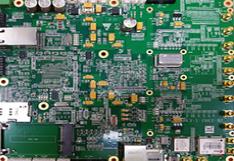PCB layout rules
1. Under normal circumstances, all components should be arranged on the same surface of the circuit board. Only when the top-level components are too dense, can some devices with limited height and low heat generation, such as chip resistors, chip capacitors, and chip capacitors, be installed. Chip IC, etc. are placed on the bottom layer.
2. Under the premise of ensuring the electrical performance, the components should be placed on the grid and arranged parallel or perpendicular to each other in order to be neat and beautiful. Under normal circumstances, the components are not allowed to overlap; the arrangement of the components should be compact, and the components should be arranged on the entire layout. The distribution is uniform and dense.
3. The minimum distance between adjacent land patterns of different components on the circuit board should be above 1MM.
4. The distance from the edge of the circuit board is generally not less than 2MM. The best shape of the circuit board is rectangular, and the aspect ratio is 3:2 or 4:3. When the size of the circuit board is larger than 200MM by 150MM, consider what the circuit board can withstand Mechanical strength.

PCB design setting skills
PCB design needs to be set at different points in different stages, and large grid points can be used for device layout in the layout stage;
For large devices such as ICs and non-positioning connectors, a grid point accuracy of 50 to 100 mils can be used for layout, while for small passive components such as resistors, capacitors and inductors, a grid point of 25 mils can be used for layout. The accuracy of the large grid points is conducive to the alignment of the device and the aesthetics of the layout.
PCB design layout skills
In the layout design of the PCB, the units of the circuit board should be analyzed, and the layout design should be carried out according to the function. When laying out all the components of the circuit, the following principles should be met:
1. Arrange the position of each functional circuit unit according to the flow of the circuit, so that the layout is convenient for signal circulation, and the signal is kept in the same direction as possible.
2. Centering on the core components of each functional unit, lay out around him. The components should be uniformly, integrally, and compactly arranged on the PCB, and the leads and connections between the components should be reduced and shortened as much as possible.
3. For circuits operating at high frequencies, the distributed parameters between components must be considered. In general circuits, components should be arranged in parallel as much as possible, which is not only beautiful, but also easy to install and easy to mass produce.
The following points should be paid attention to when PCB design specific wiring
(1) The trace length should be as short as possible to minimize the lead inductance. In low-frequency circuits, because the ground currents of all circuits flow through a common ground impedance or ground plane, avoid the use of multi-point grounding.
(2) The public ground wire should be arranged at the edge of the printed circuit board as far as possible. The circuit board should keep as much copper foil as the ground wire to enhance the shielding ability.
(3) The double-layer board can use a ground plane. The purpose of the ground plane is to provide a low-impedance ground wire.
(4) In a multilayer PCB, a ground layer can be set, and the ground layer is designed into a mesh. The spacing of the ground wire grid should not be too large, because one of the main functions of the ground wire is to provide a signal return path. If the grid spacing is too large, a larger signal loop area will be formed. Large loop areas can cause radiation and sensitivity issues. In addition, the signal return actually takes a path with a small loop area, and other ground wires do not work.
(5) The ground plane can minimize the radiation loop.